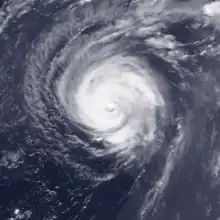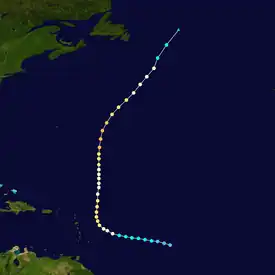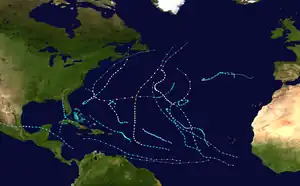 Gustav at peak intensity in the central Atlantic Ocean on August 31 | |
| Meteorological history | |
|---|---|
| Formed | August 24, 1990 |
| Dissipated | September 3, 1990 |
| Category 3 hurricane | |
| 1-minute sustained (SSHWS/NWS) | |
| Highest winds | 120 mph (195 km/h) |
| Lowest pressure | 956 mbar (hPa); 28.23 inHg |
| Overall effects | |
| Fatalities | None |
| Damage | Minimal |
| Areas affected | Lesser Antilles |
| IBTrACS | |
Part of the 1990 Atlantic hurricane season | |
Hurricane Gustav was the only major hurricane that formed during the 1990 Atlantic hurricane season.[1] Developing out of a tropical wave on August 24, Gustav tracked westward across the Atlantic Ocean, steadily intensifying. The storm reached hurricane-status on August 26 and reached its initial peak intensity as a strong Category 2 hurricane the following day. After turning towards the north and weakening due to increased wind shear, the storm encountered more favorable conditions and re-intensified, attaining peak winds of 120 mph (190 km/h) around 0600 UTC on August 31. Gradual weakening took place in the following days. on September 2, the former hurricane underwent an extratropical transition and dissipated shortly after completing it. At that time, the system was located roughly 230 miles (370 km) south of Iceland.
Hurricane Gustav initially posed a significant threat to the Lesser Antilles which had already suffered severe damages from Hurricane Hugo in 1989. Several watches and warnings were issued for the islands between August 26 and 27; however, due to the northward turn, Gustav did not directly impact the region. Only light rain and large swells were reported. Offshore, a ship encountered the storm and sustained hull damage.
Meteorological history

Tropical storm (39–73 mph, 63–118 km/h)
Category 1 (74–95 mph, 119–153 km/h)
Category 2 (96–110 mph, 154–177 km/h)
Category 3 (111–129 mph, 178–208 km/h)
Category 4 (130–156 mph, 209–251 km/h)
Category 5 (≥157 mph, ≥252 km/h)
Unknown
Hurricane Gustav originated out of a tropical wave that moved off the western coast of Africa on August 18. Shortly after, the system became embedded within the Intertropical Convergence Zone and tracked westward across the Atlantic Ocean. By August 23, the system began to intensify while convective activity become consolidated around the center of circulation. By 0600 UTC on August 24, the National Hurricane Center (NHC) estimated that the wave spawned Tropical Depression Eight roughly 965 miles (1,553 km) east of Barbados. A weak ridge of high pressure to the north of the depression led to a general westward movement of the system. Gradually strengthening, the depression was upgraded to a tropical storm early on August 25, at which time it was given the name Gustav.[2]
A cold-core low-pressure system near Gustav was forecast to have an effect on the development of the system; however, the tropical storm continued to intensify, attaining hurricane status around 1200 UTC on August 26. Not long after attaining hurricane-status, the ridge steering Gustav to the west began to break down, causing the hurricane to slowly turn towards the north.[2] By 0600 UTC on August 27, the storm attained Category 2 intensity, with winds of 100 mph (160 km/h).[3] Later that day, the storm made its closest approach to the Lesser Antilles, passing 205 miles (330 km) to the east.[2] By this time, hurricane and tropical storm-force winds extended 35 and 175 miles (56 and 282 km) from the center respectively.[4]
Tracking towards the north, Hurricane Gustav slightly weakened due to increasing wind shear,[2] with winds decreasing to 80 mph (130 km/h) early on August 29.[3] A trough located near Bermuda and the ridge located to the east of the hurricane kept Gustav on a northward track. The following day, the hurricane re-intensified and again reached Category 2 status. Early on August 31, Gustav further developed into a major hurricane, a storm with winds of 111 mph (179 km/h) or higher.[3] Around this time, Gustav began to interact with the nearby Tropical Storm Hortense, located roughly 460 miles (740 km) from Gustav. This initiated a Fujiwhara interaction between the two storms, causing Hortense to track counterclockwise around the more intense Gustav.[5] Around 0600 UTC on August 31, Hurricane Gustav reached its peak intensity with winds of 120 mph (190 km/h) and a minimum pressure of 956 mbar (956 hPa; 28.2 inHg), making it the strongest storm of the season.[3] At this time, the storm was located about 450 miles (720 km) east of Bermuda.[5]
Throughout September 1, the storm weakened and the following day, it began to track towards the north-northeast as the ridge located to the east of it strengthened. Additionally, nearby ship reports of sustained winds indicated that tropical storm-force winds extended 230 miles (370 km) northwest of the center of circulation. The trough located west of Gustav began accelerating late on September 2, causing the hurricane to track towards the northeast, away from Newfoundland.[5] Around 1800 UTC, Gustav weakened to a tropical storm, as winds decreased to 70 mph (110 km/h).[3] By this time, Gustav had entered the Canadian Hurricane Centres area of responsibility, leading to them initiating advisories on the weakening storm.[6] Early the next day, the former hurricane underwent and completed an extratropical transition. The last notice on the remnants of Gustav were while the system was located roughly 230 miles (370 km) south of Iceland.[5]
Preparations and impact
At around 1600 UTC on August 26, the National Hurricane Center issued hurricane watches for Dominica, Martinique, St. Martin, Anguilla, Guadeloupe, Antigua, Barbuda, Montserrat, and St. Kitts and Nevis. Six hours later, the watch was upgraded to a hurricane warning for Guadeloupe, Antigua, Barbuda, Montserrat, and St. Kitts and Nevis.[7] Local meteorological agencies on the islands also declared small craft advisories.[8] The local government in Montserrat mobilized the 100 member police force and 50 off-duty volunteer army members.[9] Supermarkets, hardware stores, banks, and pharmacies were specially opened for residents to purchase plywood, canned food, bottled water, and other hurricane kit items.[10] Around 1300 UTC on August 27, the hurricane watch for Dominica and Martinique was discontinued as Gustav no longer posed a direct threat to the islands. Three hours later, all watches and warnings were discontinued except for Antigua and Barbuda where a tropical storm warning and St. Martin where a tropical storm watch were in place. By 1900 UTC, once Hurricane Gustav turned towards the north away from the Lesser Antilles, all watches and warnings were discontinued.[7]
Gustav had only effects on the Lesser Antilles. Large swells, light rain, and gusty winds were reported along the outer fringes of the hurricane.[4] On August 30, the Egyptian motorship Raseltin encountered rough seas in relation to Gustav, and the hull of the ship was damaged.[11] The remnants of Gustav severely impacted a seismic research operation off the coast of the United Kingdom which took place between August 25 and September 12. The purpose of the operation was to collect seismic reflection profiles of the Rockfall Plateau. On September 3, the members of the team had to quickly retrieve all buoys that were deployed to avoid damage to the sensors. However, some of the research tools were damaged before they were recovered. In all, the storm delayed the project by two days.[12]
See also
References
- ↑ National Hurricane Center (2009). "Atlantic Best Tracks, 1851 to 2008". National Oceanic and Atmospheric Administration. Retrieved June 12, 2009.
- 1 2 3 4 Hal Gerrish (1991). "Hurricane Gustav Preliminary Report Page 1". National Hurricane Center. Retrieved June 1, 2009.
- 1 2 3 4 5 Hal Gerrish (1991). "Hurricane Gustav Preliminary Report Page 7". National Hurricane Center. Retrieved June 1, 2009.
- 1 2 Staff Writer (August 27, 1990). "Gustav spares northeast Caribbean". United Press International.
- 1 2 3 4 Hal Gerrish (1991). "Hurricane Gustav Preliminary Report Page 2". National Hurricane Center. Retrieved June 1, 2009.
- ↑ Staff Writer (September 18, 2003). "Storms of 1990". Canadian Hurricane Centre. Archived from the original on May 13, 2006. Retrieved June 1, 2009.
- 1 2 Hal Gerrish (1991). "Hurricane Gustav Preliminary Report Page 8". National Hurricane Center. Retrieved June 1, 2009.
- ↑ Staff Writer (August 27, 1990). "Gustav upgraded to hurricane". The Gleaner. Retrieved June 1, 2009.
- ↑ Staff Writer (August 27, 1990). "Hurricane Warnings Come Down As Storm Heads Past Islands". Associated Press.
- ↑ "Gustav moves past Caribbean islands". Gainesville Sun. Associated Press. August 28, 1990. Retrieved June 1, 2009.
- ↑ Staff Writer (September 4, 1990). "Casualties". Lloyd's List.
- ↑ Dr. C.P. Summerhayes (1990). "Cruise Report Number 218" (PDF). Institute of Oceanographic Sciences Deacon Laboratory. Retrieved June 1, 2009.
